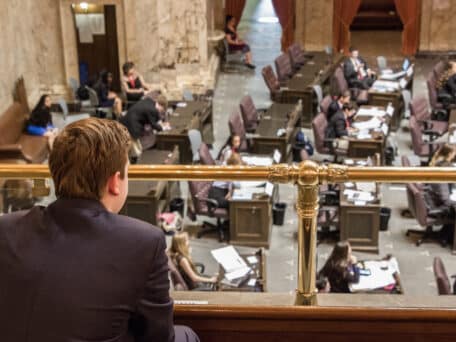According to estimates based off of information from the Puget Sound Regional Council, after 40 years and 72 miles of light rail in the Puget Sound, “fewer than 1 percent of the 19 million daily regional trips will be taken on light rail.” But, you won’t find that out from the Puget Sound Regional Council Transportation 2040 Update which regional leaders approved last spring. The update managed to grant insight on everything from bus service to tolls on major highways and urban area parking, but failed to publish any solid information on light rail. A recent op-ed in Crosscut reads,
“Overall transit use (light and commuter rail plus buses) goes from 3.1 percent today to 4.3 percent in 2040. The great majority of mass transit rides will still be on buses.
“Congestion is expected to increase 38 percent on arterials and decrease 13 percent on freeways because the plan assumes tolling on all major highways and area wide parking charges. While efforts to implement these user-based fees have been in the works for two decades, there is currently no agreement by the Legislature on when and how to implement them. These types of fees are very controversial and still don’t address the unacceptable increase in traffic on arterials due to drivers avoiding tolls. In addition, the Legislature is considering whether or not to allow Sound Transit to come back to the voters in 2016 to increase their sales and car tab taxing authority and to add property taxes.”
So, how can a transportation project taxpayers have spent so much money on offer so few actual benefits? To put it simply, bad planning based on a false assumption of the benefits of light rail. Crosscut,
“You only have to get out of downtown Seattle, or its more densely populated neighborhoods, to see why: Most people in our region don’t and won’t live and work near an existing or planned rail station. In 2040, the average household will continue to find that transit provides reasonable access – 30 minutes or less – to a tiny fraction of the region’s employment opportunities. Yes, the transit ridership numbers into downtown Seattle during rush hour are better. But this is a regional plan, and everyone is paying…
“The region should let go of the widespread myth that Atlanta and Portland are much better off because they have rail systems, and they started the systems much sooner than we did. Our region has higher transit ridership than either of them, much higher than Atlanta, and highway congestion is worse in Atlanta and not much better in Portland. Seattle actually is in the top 10 cities in the U.S. for transit ridership; over 99 percent of that ridership is by bus. Even after we voted to build light rail 20 years ago, it carries only about 0.25 percent of the trips in the region.”
According to the Crosscut op-ed, there is a better, more effective solution. One example is the bus rapid transit (BRT) system already in place. BRT offers riders “rapid boarding, limited stops and less congested special lanes.” And, BRT “can be in place in a matter of years, not decades, and can reach many more people… We’ve invested billions of dollars in 310 miles of HOV lanes. Let’s use them to move carpools and buses better.”
Sound Transit has proved that it has failed taxpayers. Time and time again, Sound Transit has broken light rail promises. And, time and time again, they have asked taxpayers to trust them with more of their hard-earned dollars anyway. The Crosscut op-ed writers urge the state Legislature not to grant Sound Transit its latest $15 billion tax authority demand until four simple obligations are met. Crosscut,
- Put performance measures up front and center. Planners should clearly and consistently state the region’s goals and projected and actual performance measures for all critical components of transportation, including ridership for each type of transit and cost per new rider; carpool/vanpool ridership and cost per new rider; speed and percent of growth in urban centers; and access to jobs by transit.
- Identify how the state will deliver on its commitment to keep traffic in the HOV lanes moving at 45 mph or faster 90 percent of the time.
- Require consistency among plans. Explain the justification for PSRC specifying tolls in its Transportation 2040 Plan for all lanes of freeways and expressways when the Legislature is not considering them and there is no other plan to prevent soaring congestion.
- First, do no harm. Do not allow any further Sound Transit tax increases to be on the ballot until these three requirements have been met.




